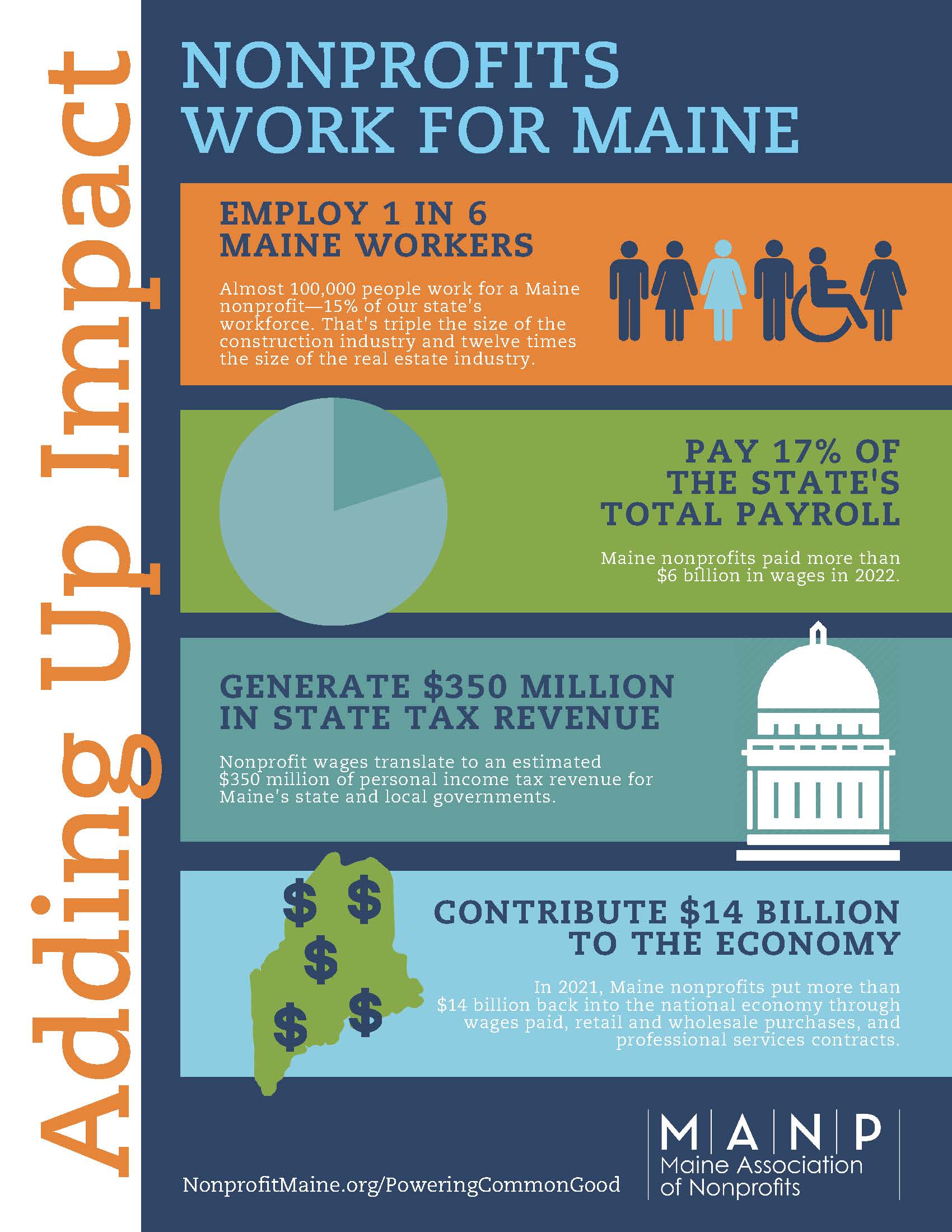Nonprofit Research
Just as we need to understand the trends and impact around tourism, construction, or the fishing industry as they relate to our economy and society, we need to understand the significant role that nonprofits play in our communities.

Adding Up Impact
MANP conducts regular research on Maine’s nonprofit sector to help organizations, individuals and policymakers better understand the vital role of nonprofits in creating, sustaining and improving Maine’s quality of life.
Key Findings About Maine Nonprofits
MANP’s latest analysis, drawn from 2021 IRS filings and 2022 Maine Department of Labor data, affirms nonprofits are vital to Maine’s economy and quality of life. Nonprofits:
- Contribute more than $14 billion dollars per year to the economy through wages paid, retail and wholesale purchases, and professional services contracted.
- Pay $6 billion annually in wages, which translates to an estimated $350 million in personal income tax revenue for Maine.
- Employ 15% of Maine’s workforce: that’s 1 in 6 Maine workers and about 100,000 jobs!
- Mobilize around 400,000 volunteers per year who donate approximately $1 million of time + talent to improve Maine communities.
For a more in-depth look at the size and scope of Maine's nonprofit sector, download the 2021 Adding Up Impact report, based on 2018 IRS filings and 2019 Maine Department of Labor data.
Other Nonprofit Research
There are many sources for information about nonprofits and the challenges and trends influencing their work.
General
- Nonprofit Impact Matters (National Council of Nonprofits)
- Nonprofit Economic Data Project (Johns Hopkins) - data on nonprofit finances, employment and wages, and volunteering, including the Nonprofit Works interactive database
- Health of the U.S. Nonprofit Sector Quarterly Review (Independent Sector)
- State of the Nonprofit Sector (Nonprofit Finance Fund)
- Partnering for Impact: Government-Nonprofit Contracting Reform Task Forces Produce Results for Taxpayers (National Council of Nonprofits)
- New England's Creative Economy (NEFA)
- The IRS’s Exempt Organizations Business Master File Extract (EO BMF) is a downloadable data set of all tax-exempt organizations in the United States. The data are extracted monthly and are available by state and region. The IRS also makes available an Annual Extract of Tax-Exempt Organization Financial Data.These extracts contain selected financial data from filers of three Internal Revenue Service (IRS) information returns — Forms 990, 990-EZ and 990-PF.
- Meeting the Need: Building the Capacity of Community-Based (Building Movement Project, December 2022)
- Exploring the Social Sector Intrastructure (Urban Institute)
COVID-19
- COVID-19 Impact on Nonprofits: A Sector in Change (Public Allies, May 2020)
- The 2020 Nonprofit Employment Report: The 3rd largest employer faces the COVID-19 crisis (Johns Hopkins Center for Civil Society Studies, Jun 2020)
- The Impact of COVID-19 on Large and Mid-Sized Nonprofits (Independent Sector, June 2020)
- COVID-19’s Impact on Nonprofits’ Revenues, Digitization, and Mergers (David LaPiana in Stanford Social Innovation Review, June 2020)
- COVID-19 Workforce Trends Report (UST) – based on data from 800 organizations from late March to late April
- The Continuing Impact of COVID-19 on the Social Sector (LaPiana Consulting, May 2020)
- Perspectives from Main Street: The Impact of COVID-19 on Communities and the Entities Serving Them (The Federal Reserve System, April 2020)
Governance and Leadership
- Race to Lead (Building Movement Project)
- Leadership New England (TSNE MissionWorks)
- Leading with Intent (BoardSource)
Compensation
Fundraising + Communications
- Fundraising Effectiveness Project (Association of Fundraising Professionals (AFP), the AFP Foundation for Philanthropy, and the Center on Nonprofits and Philanthropy at the Urban Institute)
- Giving USA (Collaborative effortsof Giving USA Foundation, a public service initiative of The Giving Institute, and Indiana University Lilly Family School of Philanthropy)
- M+R Benchmarks
- Nonprofit Communications Trends (Nonprofit Marketing Guide)
Volunteerism
- Volunteering and Civic Life in America (Corporation for National & Community Service and the National Conference on Citizenship)
More Data Sources for Nonprofits
Data Innovation Project’s Data Scan compiles data sources that are reputable, relevant to the work of organizations in Maine, accessible, and free. You can search by overarching category (Communities & People, Health, Education, and Economy) or use keywords to search. Different filtering options allow you to search by level of data, which will show you the smallest level of data available from that source (e.g., county level), year, or format (e.g., pdf or Excel). You have the option of downloading or printing what you find in the scan.
